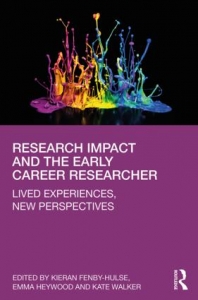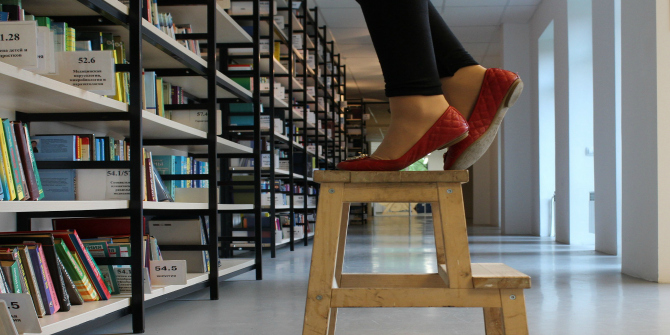In Research Impact and the Early Career Researcher: Lived Experiences, New Perspectives, Kieran Fenby-Hulse, Emma Heywood and Kate Walker bring together contributors to offer different voices on how researchers experience and respond to the demand for impact. Since the conceptualisation, search for and realisation of impact can have different effects on ECRs, this collection will help ECRs become more familiar with how others have coped with this weight and will also be useful to mentors, supervisors and department heads who are looking to support ECRs in achieving impact, writes Raul Aldaz.
Research Impact and the Early Career Researcher: Lived Experiences, New Perspectives. Kieran Fenby-Hulse, Emma Heywood and Kate Walker (eds). Routledge. 2019.
Higher Education (HE) in the UK and elsewhere has turned its attention to the effect that research has (or should have) beyond academia. This effect is usually captured by the word ‘impact’. Policies, organisations and researchers are adapting to this new guiding principle for academic research and do so under different starting points and conditions. The assessment of research impact – and the changes that it creates – places new demands on organisations and academics, who, in turn, need to adapt to these new sets of conditions. As this process of adaptation evolves, what roles do early career researchers (ECRs) play and how do they experience them? This book provides views, from different angles, that address this question.
Why is it relevant to know more about how ECRs address and experience the need to show research impact? In the current context of HE in the UK and beyond, ECRs face a number of pressing demands within a sometimes hostile environment. On the one hand, and as the book highlights when locating itself, ECRs experience job insecurity, short-term contracts, financial uncertainty, increasing workloads and poor or absent mentoring. On the other hand, ECRs are expected to acquire more and better teacher training (including teaching qualifications), produce high-quality research and – additionally – show research impact. In this scenario, it is not improbable to conceive ‘insecurity and low productivity traps’, where ECRs accept short-term jobs with heavy teaching loads that do not create space for the production of research outputs that could lead to more professional and financial certainty. Thus, adding one more domain for the assessment of ECRs has professional and personal implications, some of which are addressed in this book.
Research Impact and the Early Career Researcher presents chapters that reflect on the experiences that ECRs have had in relation to research impact. The collection is not a manual or textbook on how to achieve impact, but instead presents different voices on how researchers experience and react to the demand for impact. To this end, the book organises itself in three parts that aim to cover the connection between impact and researchers, some of the demands that impact creates for researchers and how structures shape researchers’ response to impact. Additionally, the book combines longer chapters with shorter ones that extend and echo a similar topic from a more personal standpoint. There is nevertheless wide variety in the approaches taken across the chapters, which some readers might find eclectic, from short research-based chapters to personal – even existential – reflections.

The first section puts together different views on how researchers relate to impact. Traditionally, it has been thought that academics teach and do research, but as HE systems begin to focus on impact, academics’ roles also change. As a result, academics would likely experience the tensions derived from professional transformation. Chapter One by Ged Hall, Helen Morley and Tony Bromley lays out the setting in which research impact emerges and how ECRs fit in; the main take-away here is that ECRs can find their path to impact in spite of an uncertain and confusing scenario. Developing an academic identity is not just about how ECRs see their research agenda relative to a discipline or topic, but also about how and from what position ECRs engage with society beyond academia. This process of professional transformation entails personal disruption, self-examination and eventually change. For instance, in Chapter Two, Tracey Hayes traces the path of how a specific academic identity emerged from personal histories, research substance and self-reflection; this was a powerful and intimate account of how an ECR’s voice emerged and how this voice positioned the researcher vis-a-vis her work and her role beyond academia. It is very likely that readers would find reassurance, confidence and even optimism from reading about the paths that others have taken.
The second part of the book puts together a collection of chapters on research impact and collaboration. The way that ECRs interact with other researchers and audiences shapes how they approach impact. For example, one pathway to impact can be adopting the role of knowledge broker as explored in Chapter Four by Louise Maythorne: that is, gathering codified academic knowledge and translating it to other more specific audiences. This is a two-way process that facilitates not only the use of information that was previously contained in classrooms or labs, but also the channelling of ‘real life’ problems into academic debates. Of course, exchanges can vary according to the specificities of external audiences but making this process explicit can help ECRs devise their own strategies. In Chapter Five, Robert Meckin and Sandrine Soubes look into the experience of interdisciplinary collaboration among ECRs in a HE institution; interdisciplinary collaboration can unveil paths for impact not explored before, especially when collaboration crosses the social, natural or medical science divides. This section is perhaps the one that offers more practical takeaways, even if it was not conceived with that purpose.
The final section inserts ECRs’ experiences within specific contexts to elaborate on how structures shape the way ECRs approach research impact. In Chapter Seven, Ke Yu, Ian Edelstein and Balungile Shandu present research outputs that describe the specific characteristics of ECRs in South Africa and suggest how to move forward; ECRs here, in spite of the constraints that they face, appear motivated to achieve impact. The authors also show that the potential for impact and the demand for it are not always connected, which would require – they argue – more specific interventions. Another angle to see how contexts matter comes from looking more carefully at doctoral training. As explored in Chapter Eight by Rebekah Smith McGloin, we should expect that HE systems and doctoral training would shape how ECRs aim to have an effect beyond academia; more traditional PhD programmes can learn from professional doctoral training in connecting the development of research skills with industry-driven demands. Also, given that HE systems, organisations and doctoral training vary, we might expect that this variation would also map on different starting points, tools to embed impact in research designs and – eventually – impact itself. From another perspective, Fenby-Hulse argues that ECRs are part of research ecosystems where users and producers of knowledge interact, so a more conscious mapping of these ecosystems would likely lead to a more effective engagement with impact.
The book offered me two main messages. First, the variety of personal experiences can help the anxiety that ECRs may experience regarding impact; the conceptualisation, search for and realisation of impact can have different effects on ECRs, and being familiar with how others have coped with this weight before – albeit under varying circumstances – can facilitate how ECRs navigate this process. Second, while it is not their explicit intention, some chapters can help in reflection on the processes or organisational features that ECRs can use to design their own impact strategies. Nonetheless, as is the case with edited volumes, there is variation in how each chapter might resonate with an individual reader’s histories and expectations.
Early Career Researchers are a clear target for this book, but other readers can benefit as well. Mentors, supervisors, directors of doctoral programmes and heads of departments, who are likely asking themselves what they are doing to equip the ECRs they oversee with better tools for research impact, will also find value in reading this book. Doing so could help them develop empathy for what ECRs experience and consider ECRs’ perceptions when designing strategies to support them in this task.
Note: This review gives the views of the author, and not the position of the LSE Review of Books blog, or of the London School of Economics.


 Find this book:
Find this book: 





1 Comments